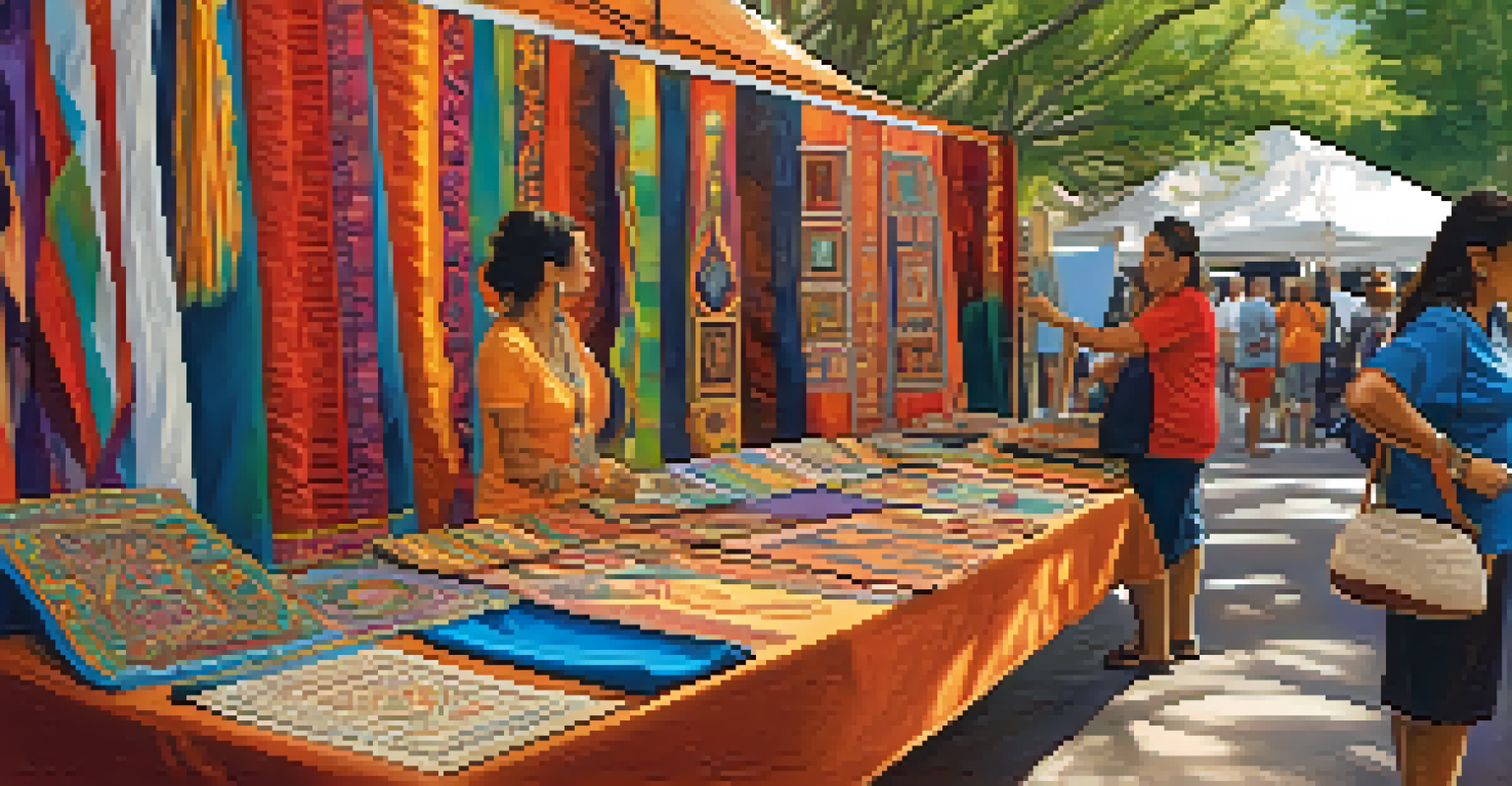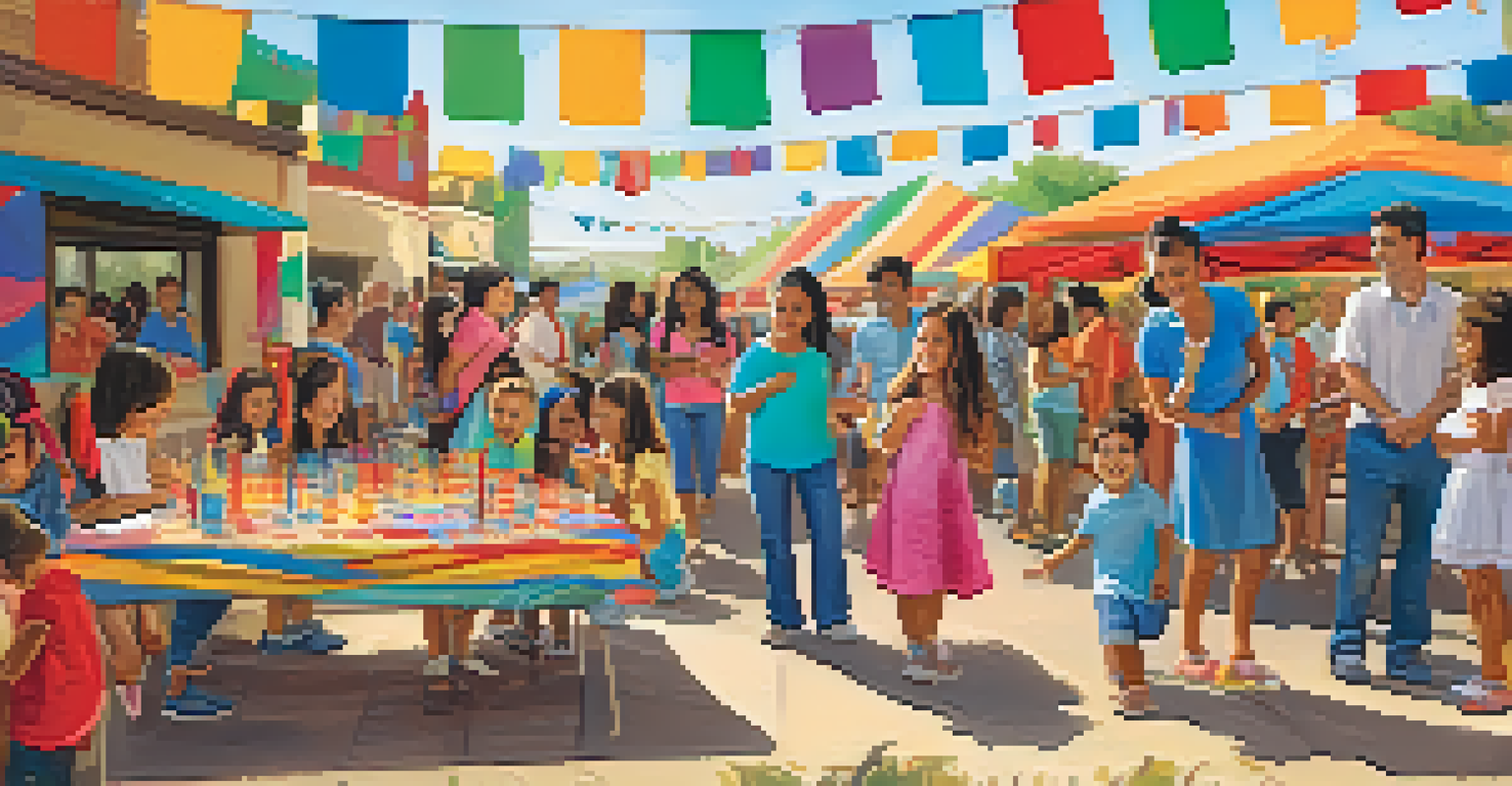Exploring California's Vibrant Hispanic Heritage Festivals

A Glimpse into California's Hispanic Heritage
California is a melting pot of cultures, with Hispanic heritage playing a vital role in its identity. From the Spanish missions to the vibrant neighborhoods of Los Angeles, the influence of Hispanic traditions is evident everywhere. These festivals celebrate the rich history, music, art, and culinary delights that Hispanic communities have contributed to the Golden State.
Food is our common ground, a universal experience.
Each festival tells a story, often rooted in deep cultural significance. For instance, events like Dia de los Muertos not only honor deceased loved ones but also emphasize the importance of family and remembrance. These gatherings are a beautiful way to connect present generations with their ancestors, showcasing traditions that have stood the test of time.
As we explore these festivals, we'll see how they serve as a bridge between cultures, inviting everyone to join in the celebration. They offer a unique opportunity for Californians and visitors alike to experience the warmth and vibrancy of Hispanic culture while promoting understanding and appreciation across diverse communities.
Popular Hispanic Heritage Festivals Across the State
California hosts numerous Hispanic heritage festivals throughout the year, each with its own distinct flair. One standout is the Fiesta Broadway in Los Angeles, which draws in crowds with its lively parades, music, and delicious food. This festival not only showcases Latino culture but also serves as a platform for community organizations to advocate for important issues.

Another notable event is the San Diego Latino Film Festival, which highlights the contributions of Latino filmmakers and artists. Here, attendees can enjoy screenings, workshops, and panels, making it a significant cultural gathering. It's a perfect example of how festivals can blend entertainment with education, fostering a greater appreciation for Hispanic storytelling.
Celebrating Hispanic Heritage
California's festivals showcase the rich traditions, music, and culinary delights of Hispanic communities.
In Northern California, the San Francisco Carnaval is a vibrant celebration that combines music, dance, and art. This festival showcases the rich diversity of Latin American cultures, featuring colorful parades and performances that captivate audiences. Each of these festivals reflects the unique heritage of the communities they represent, making them essential to California's cultural landscape.
The Role of Food in Hispanic Heritage Festivals
When you think of Hispanic heritage festivals, one of the first things that comes to mind is the food. From tacos to tamales, the culinary offerings are often a highlight of these celebrations. Food plays a crucial role in connecting people to their roots, as traditional dishes are often passed down through generations, each with its own story.
Music is the shorthand of emotion.
At these festivals, attendees can indulge in a variety of authentic dishes, prepared by talented chefs and home cooks alike. For example, the annual Taste of Mexico Festival in San Diego features not only traditional fare but also cooking demonstrations that teach attendees how to recreate these beloved recipes at home. It's a delicious way to engage with culture and history.
Moreover, food brings people together. Sharing a meal can foster connections and spark conversations, allowing guests to learn more about each other's backgrounds. The communal aspect of dining at these festivals helps to break down barriers, creating an inviting atmosphere that celebrates diversity and unity.
Music and Dance: The Heartbeat of Festivals
Music and dance are essential components of Hispanic heritage festivals, breathing life into the celebrations. Genres such as mariachi, salsa, and cumbia echo through the streets, inviting everyone to join in the festivities. These lively performances not only entertain but also celebrate the history and cultural significance of each style.
Take the annual Los Angeles Mariachi Festival, for example, where talented musicians showcase their skills and passion. This event highlights the importance of mariachi music in Hispanic culture, offering workshops for aspiring musicians and opportunities for established artists to shine. It's a heartfelt tribute to a genre that has brought joy to countless people.
Cultural Connections Through Food
Food at these festivals serves as a vital link to heritage, fostering community and connection among attendees.
Dance, too, plays a vital role in these festivals, with traditional folk dances showcasing the rich heritage of different regions. The colorful costumes and rhythmic movements tell stories that resonate with audiences, creating a dynamic experience. Through music and dance, these festivals become a living expression of culture, bringing communities together in joyful celebration.
Art and Craftsmanship at Hispanic Heritage Festivals
Artisan booths can be found at nearly every Hispanic heritage festival, displaying a stunning array of crafts that reflect the cultural diversity of the community. From handmade jewelry to vibrant paintings, these pieces often carry significant cultural meanings and stories. They serve as a visual representation of the rich traditions that have been passed down through generations.
Many festivals also feature live demonstrations where artisans showcase their skills, allowing attendees to connect with the craftsmanship firsthand. For instance, at the Festival de la Guelaguetza in Los Angeles, visitors can watch artisans create intricate textiles and pottery, gaining insight into the techniques that have been preserved over time. This interactive experience deepens the appreciation for the artistry involved.
Moreover, supporting local artisans helps to sustain cultural heritage and promote economic growth within the community. By purchasing these unique crafts, festival-goers contribute to the livelihoods of artists while fostering a sense of pride in their cultural identity. In this way, art becomes not just a showcase but a vital thread in the fabric of the festival experience.
Family-Friendly Activities at Festivals
Hispanic heritage festivals are designed to be inclusive, with a variety of family-friendly activities that cater to all ages. From face painting and craft stations to traditional games, there's something for everyone to enjoy. These activities help to create lasting memories for families, encouraging them to explore and engage with the culture in a fun and interactive way.
Many festivals also feature storytelling sessions that captivate young audiences, often sharing tales that highlight important cultural values and history. These stories resonate with children and adults alike, fostering a sense of connection to their heritage. It’s a wonderful way to educate the younger generation about their roots while having fun.
Inclusivity in Festival Evolution
Hispanic heritage festivals are evolving to embrace inclusivity, representing diverse voices and integrating modern technology.
Additionally, children's performances are frequently showcased, allowing kids to shine on stage and share their talents with the community. This not only boosts their confidence but also instills a sense of pride in their heritage. By offering these family-oriented activities, festivals ensure that the celebration of Hispanic culture is passed down to future generations.
The Future of Hispanic Heritage Festivals
As California continues to evolve, so do its Hispanic heritage festivals. With an increasing emphasis on inclusivity, these events are adapting to represent a broader range of cultures and experiences. Organizers are putting more effort into showcasing the intersectionality within the Hispanic community, allowing for more voices to be heard and celebrated.
Moreover, the integration of technology is transforming how festivals engage with attendees. Social media platforms and apps are being utilized to provide real-time updates, enhance visitor experiences, and promote festival activities. This modern approach helps attract younger generations, ensuring that the rich traditions of Hispanic heritage remain relevant in today's fast-paced world.

Looking ahead, the resilience and creativity of these festivals will undoubtedly continue to thrive. As communities unite to celebrate their heritage, they will foster deeper connections and understanding among diverse populations. The future holds exciting possibilities for Hispanic heritage festivals, ensuring that this vibrant culture will continue to flourish for years to come.